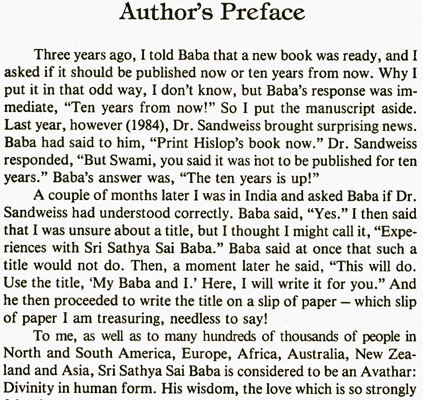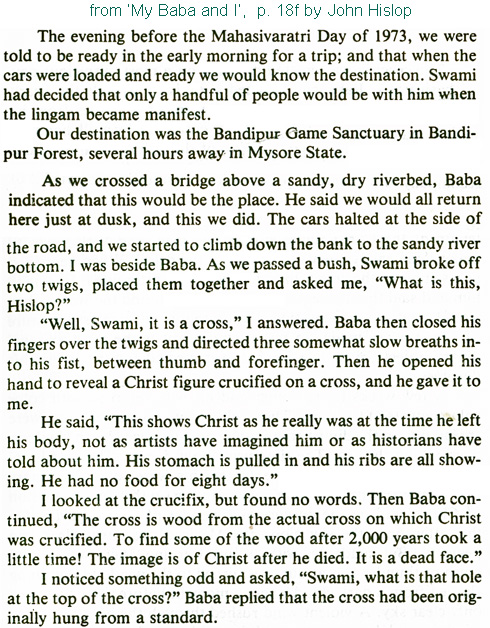
'My Baba and I' - the follow-up book to 'Conversations...'

'My Baba and I' - the follow-up book to 'Conversations...'

For hundreds of thousands of readers, My Baba and I by Dr. John Hislop, [1985: Birth Day Publishing, San Diego] has been one of the principal introductory books on Sathya Sai Baba. It is translated into many languages. The title was chosen by Sai Baba and the book deals with Hislop's prolonged and intimate experiences of Baba's teachings. The second book by Hislop on Sathya Sai Baba contained many much more extraordinary materials about alleged Sai miracles that Hislop claims to have experienced through many of his years of being a follower. The scan from the preface on the right sets the tone of the book, which tone I characterize as a the product of what by then was a completely uncritical, highly indoctrinated and suggestible mind. Hislop's writing about his Lord and Master almost reeks of naivety or gullibility, but even so it is not taken to the excessive lengths of subservient mind-boggled pseudo-poetry of the 'official biographer' Professor N. Kasturi or of biographical devotees like Smt. Vijaya Kumari ('Vijayamma')

Comment:- The Crucifix was allegedly 'materialised' for Hislop by Baba on Mahasivatratri, 1973. This occurred on a car trip to have a picnic. These trips were arranged by his servitor, Colonel Joga Rao (who did not believe in Sai miracles, but who evidently conspired with Sai Baba to facilitate the fraudulence. Joga Rao’s reason for this reportedly was that Sai Baba would thereby become able to get funds to help the poor etc.. Sai Baba took a twig [certainly enclosed it in his hand as he always does] and blew on it, and when he opened it the crucifix was seen.
Dr. John Hislop readily believed what Sai Baba told him, namely, that the crucifix was made from a piece of the original wood of the Cross. Of course, no carbon dating was done – for it would surely disprove that. Serious scientists would not bother to go to such lengths to disprove such a cheap trick, and Hislop would never have tried because he worked entirely on blind faith. Besides, one does not know what became of the crucifix after his death in 1996 but, probably, it was hidden away from public inquiry.
It haslong been exposed: a magnified photo of the amulet was examined by an art expert emeritus professor, William S. Dale Ph.D. and proclaimed most likely to be a commonly manufactured amulet from the 19th century UK, with visible small defects due to the mass/casting process. (See more here). There is a serious defect in the crucifix too, for the nails in actual crucifixions passed through the wrist, because nails through the hand could not support a weight of the body. It also has a hole at the top of the cross, so Hislop asked his Lord and master what it was. Sathya Sai Baba, improvising as usual, told him the cross had been suspended from above!
The same kind of small crucifix is available from shops and markets in India for a small amount of money. The hole is quite evidently for a locket chain so it can be worn around the neck, not for Sathya Sai's reason - i.e. hanging of the original cross from above. (See "The fake crucifix" and also comments at http://www.exbaba.com/articles/premanand3.html).
See comments by investigators on the crucifix: Piet Vroon, wrote in “Santa Claus in India” in Indian Skeptic 6(4), August 1993: ("air bubbles identical with those caused by techniques of inexpensive mass reproduction, and standard but historically inaccurate iconographic features such as nails through palms")
Uno Langmann's Comments on the Crucifix - 1988: (" an ordinary inexpensive crucifixion depiction... of soft metal such as pewter or lead. The casting is cheap and not very skillful... little air bubbles around the feet indicate it was made by cheap plaster of Paris mold... small manufactured nails... wood appears to be low-grade hardwood of some sort. I believe I have seen this sculpture image before...)
Further strange claims and self-contradictory remarks are made both by Hislop and Sai Baba in the book. Here are a few examples:-
(J.Hislop. My Baba and I. Indian edition, p.188)
SAI: Crime has become very bad in India. There is no safety.
JOHN HISLOP: Swami, this is not particular to India. The same is true all over the world. How will it end?
SAI: To the good. In a few years, all will be peaceful.
JH: But Swami, it is getting worse, and it is the Kali Yuga (a world period of diminishing virtue).
SAI: No. It is not as bad now as it was. It is like in the ocean. There is a time of high waves, and there may be some peak waves that crash heavily on the shore, but this is followed by a calm and peaceful sea.
JH: We are fortunate to be alive so that we may see this peaceful world.
SAI: You will all see it. Even the old men will live to see it.
(Interview of 1978)
Comment: More than "a few years" have passed since 1978, but things are still very bad in India. One can say there is still no safety. Consider one item only: UNICEF reports "With an estimated 12.6 million children engaged in hazardous occupations (2001 Census), for instance, India has the largest number of child labourers under the age of 14 in the world." (or see also here) This is but one of countless major issues of lacking public safety in India. When Hislop died in 1995, the world could hardly have been considered to be peaceful, nor is it in 2010.
(J.Hislop. My Baba and I. Indian edition, p.189)
SAI: In all countries there is a rapid deterioration of the human quality.
JOHN HISLOP: When will it change for the better?
SAI: Soon there will be a change.
JH: When is soon, Swami? Twenty years? Ten years?
SAI: No. Now. Already there is some slight improvement in India. One cause of the general deterioration in the world is rapid communication. This allows advertising and publicity to have a strong influence on people. Your American election is an illustration of how the leaders are television actors.
JH: Swami, there is no evidence of a change for the better.
SAI: If there is a change, it will be a universal change. Not local. It will occur every place.
(Interview of 1980)
Comment: Sai Baba, when buttonholed for once by Hislop, defines his word 'soon' and meaning 'Now', on the grounds that there was already some "slight improvement" in India then. For the hundreds of millions below subsistence levels things have hardly changed at all and often got worse by 2010.
See also:-
Review of 'Conversations with Bhagavan Sri Sathya Sai Baba' by Dr, John Hislop
Final book by Hislop "Seeking Divinity" (publ. posthumously 1998)